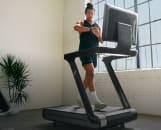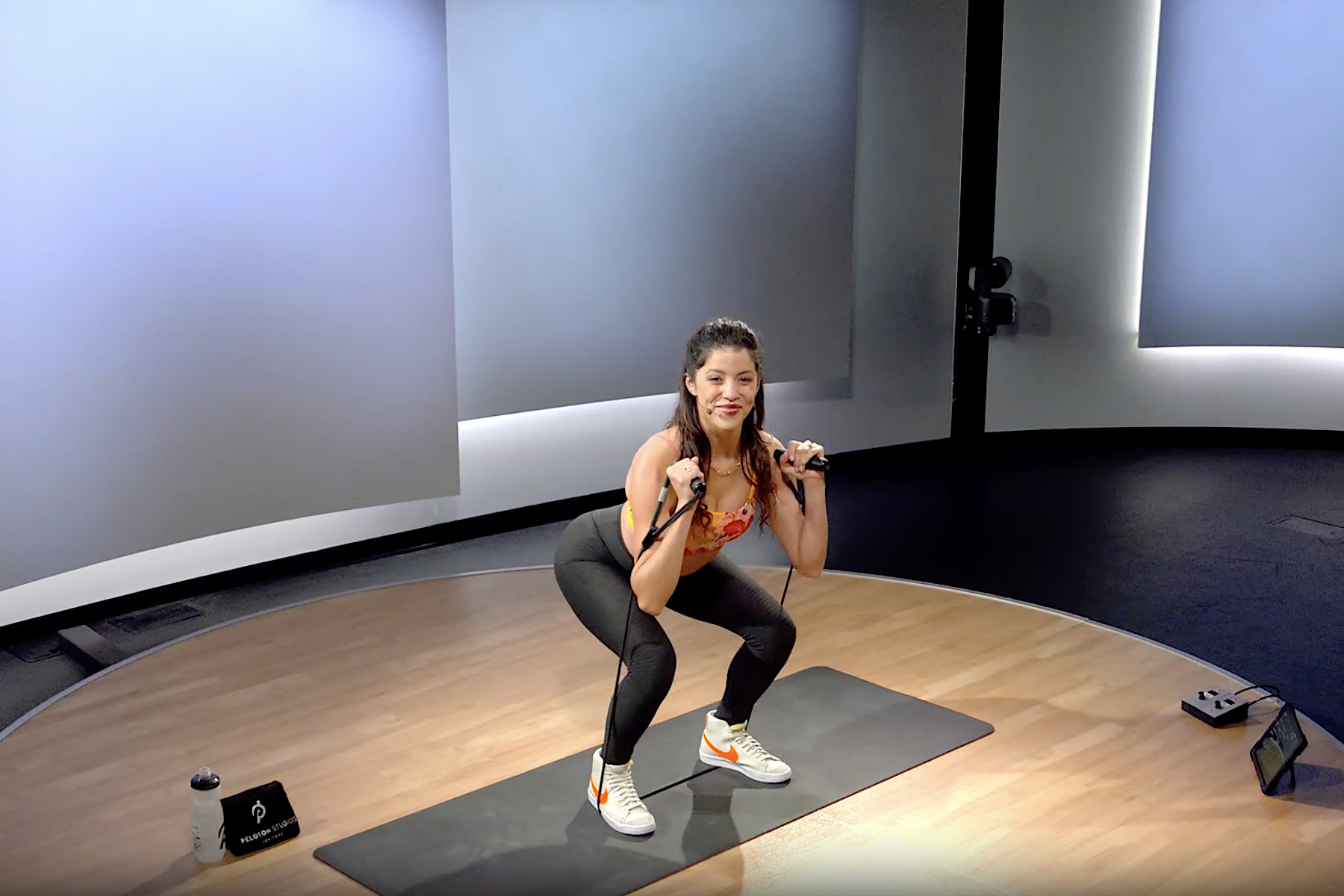
18 Amazing Resistance Band Exercises to Build Strength
There's no need for dumbbells—you can build full body strength with these resistance band moves.
By Team Peloton, Renee Cherry•
The Benefits of Resistance Band Exercises
Resistance Band Exercises for Upper Body Strength
Resistance Band Exercises for Lower Body Strength
Resistance Band Exercises for Core Strength
How to Choose the Right Resistance Bands
How to Get Started with Resistance Band Workouts
Resistance bands tend to get overshadowed by other strength training tools like dumbbells, barbells, and kettlebells. But in truth, resistance band exercises have many advantages, making them a staple for your fitness routine.
While physical therapists often use resistance bands as a tool for injury rehabilitation, resistance bands can also provide a complete, total body workout. You shouldn’t be sleeping on the benefits of including resistance band workouts in your routine as a way to strengthen your upper and lower body without introducing extra strain or heavy impact.
Learn more about the benefits of resistance band training, and 13 highly effective resistance band exercises that you can use for a full body workout.
The Benefits of Resistance Band Exercises
Resistance bands are a convenient tool that can up the intensity of your strength workouts without adding machines or free weights. They’re stretchy elastic bands that usually have looped handles, and can be purchased in varying degrees of tension and lengths. They use oppositional force to target muscles in a low-impact way without relying on gravity to create resistance.
Much as with weights, it’s ideal to have a light, medium, and heavy band, but you can still get a highly effective workout with a single band in your arsenal. They’re also lightweight, portable, and easy to store, making them perfect for travel and use in small spaces.
The physical benefits of using resistance bands for workouts are vast. You can use resistance bands to target big muscle groups, but they’re also useful for targeting smaller stabilizing muscles that are harder to target with dumbbells and traditional weight training. Research suggests that resistance band exercises can improve balance, mobility, and gait function over time.
Below, we break down some of the most popular resistance band exercises you can try that’ll help you build both upper and lower body strength and endurance.

Peloton App
Access thousands of classes with no equipment needed.
Resistance Band Exercises for Upper Body Strength
Resistance band exercises offer versatility; they let you build upper body strength without having to rely on heavy weights or bulky gym equipment. Here are a few examples of upper body resistance band exercises you can try at home:
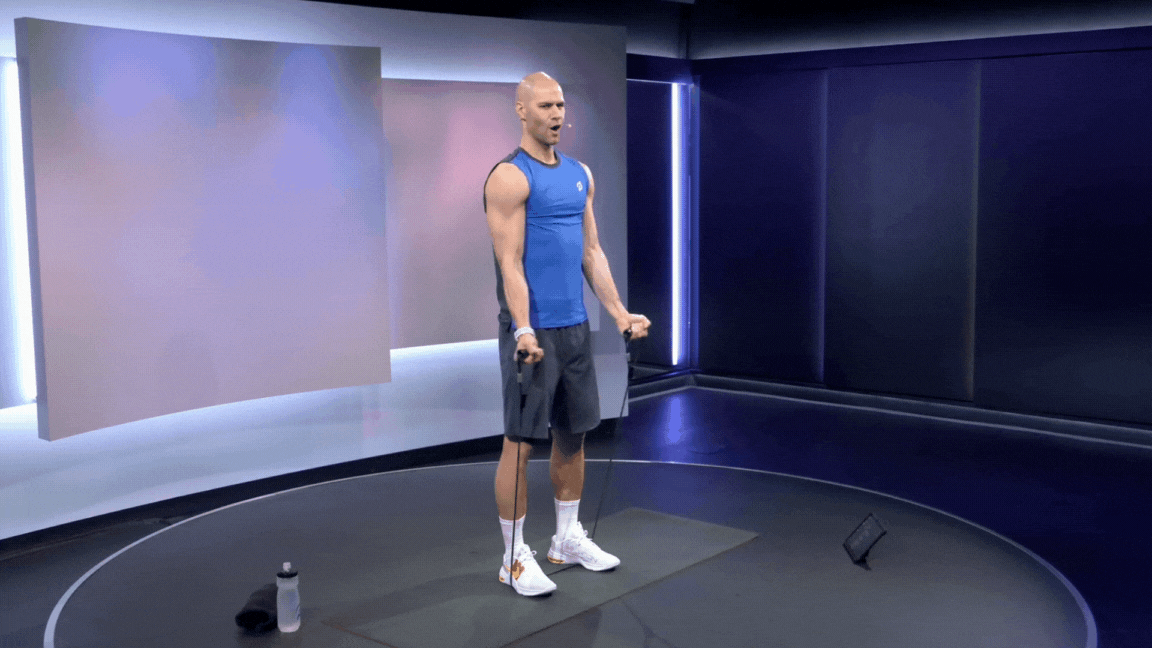
Biceps Curl
This exercise isolates and targets your biceps, the muscles on the front of your upper arm.
Stand on a band with your feet shoulder-width distance apart and a slight bend in your knees. Hold a handle in each hand, arms by your sides with palms facing forward.
Keeping your elbows fixed by your sides, bend your right elbow to lift your hands toward your shoulders, contracting your biceps.
Slowly straighten your arms to lower your hands back to your sides.
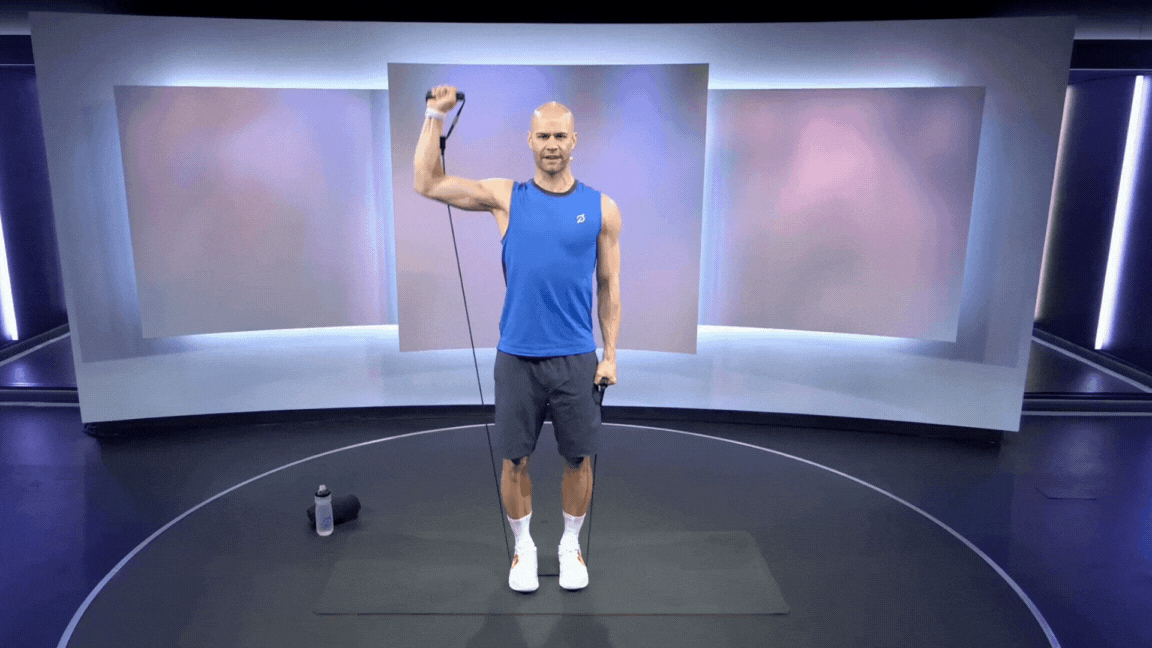
Single-Arm Overhead Shoulder Press
The overhead press (aka shoulder press) strengthens your shoulders. When you do it as a unilateral exercise (i.e., one side at a time), your core also kicks in, working hard to keep your torso upright.
Stand on a light resistance band, holding a handle in each hand, your left hand down by your side and your right hand at shoulder height. Lift your right arm so your elbow is directly out to the side of your body, bent at a 90-degree angle, and your upper arm is parallel to the ground, palm facing forward.
Press your right hand overhead to straighten your arm, pausing when your hand is directly over your shoulder.
Slowly lower you arm with control to return to the starting position.
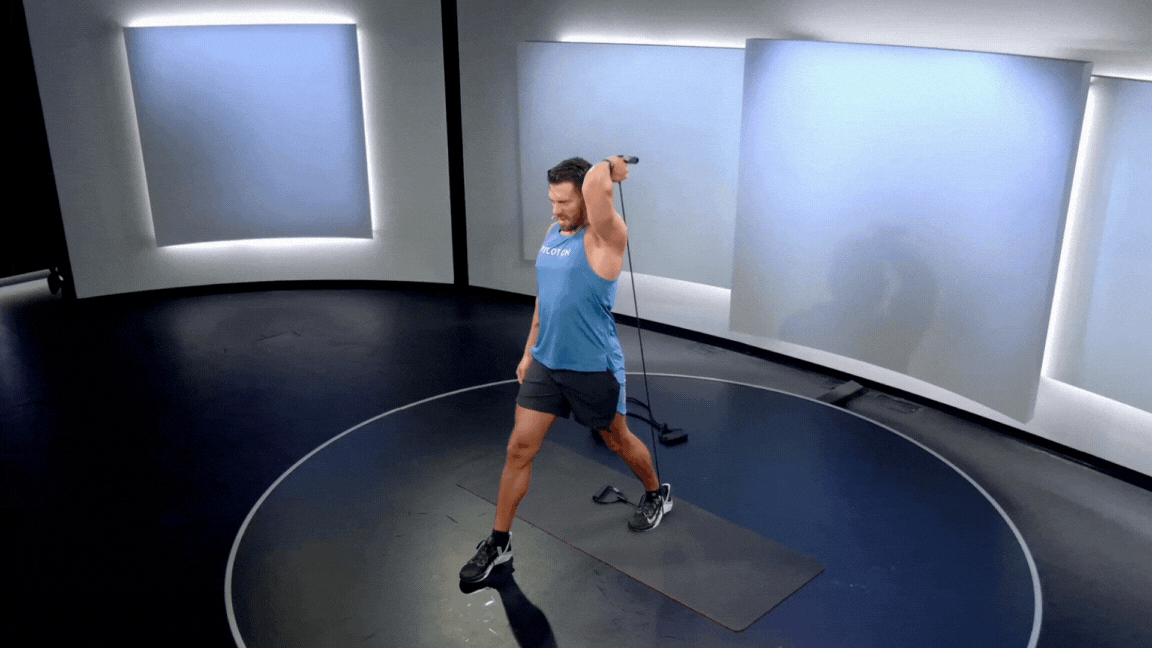
Single-Arm Triceps Extension
This is an effective way for you to work your triceps with some extra resistance sans weights.
Stand with your right foot in front of your left, and the end of the resistance band under your left foot. Hold the other end of the resistance band in your left hand, either holding onto the handle or the band just in front of the handle.
Press your left hand overhead, bicep by your ear. Keeping your elbow close to the side of your head, slowly bend your elbow to lower your left hand behind the back of your head. This is your starting position.
Pull the resistance band up toward the ceiling to straighten your arm, squeezing your triceps.
Pause for one second at the top, then bend your elbow to slowly lower your left hand behind your head and return to start. Keep your core engaged and hips square throughout the movement.
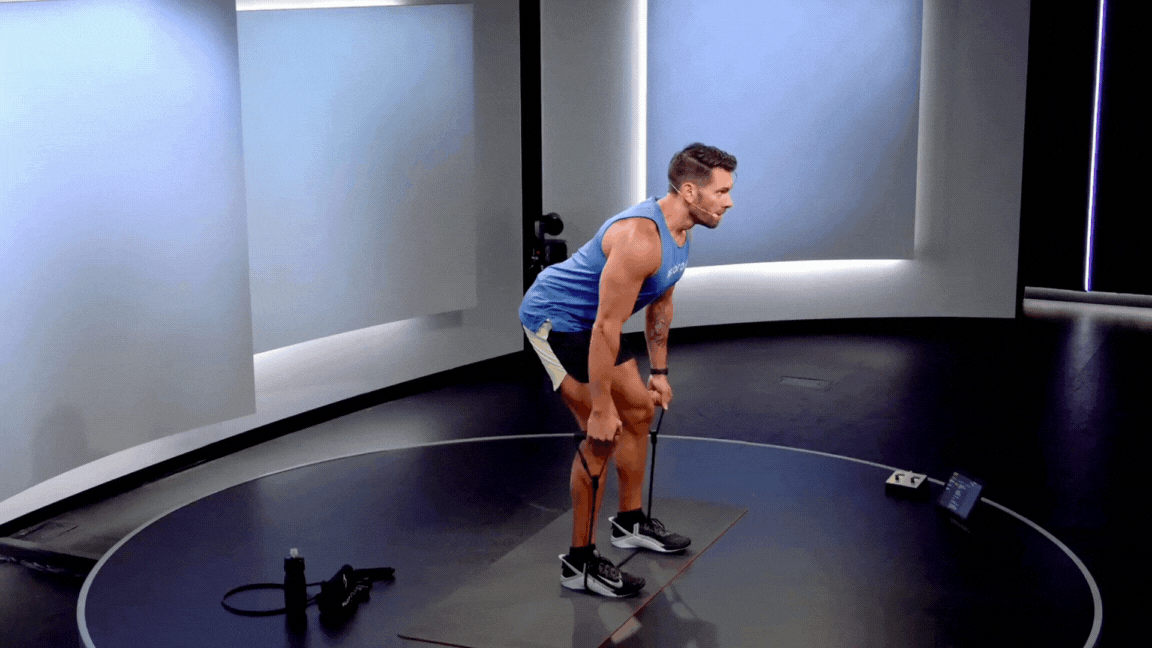
Bent-Over Row
The bent-over row is a classic back strength exercise typically done with a barbell or other free weights, but you can also do it with a resistance band to work your arms and muscles up and down your back.
Stand with a resistance band running horizontally under both feet and hold a handle in each hand. Draw your belly button to your spine, bend your knees slightly, then hinge forward slightly at your hips until your torso is almost parallel to the floor, keeping your hands near your knees.
Squeeze your shoulder blades together as you draw the handles toward your lower ribs, elbow pulling straight back.
Pause for a second, then straighten your arms to lower the band and return to start.
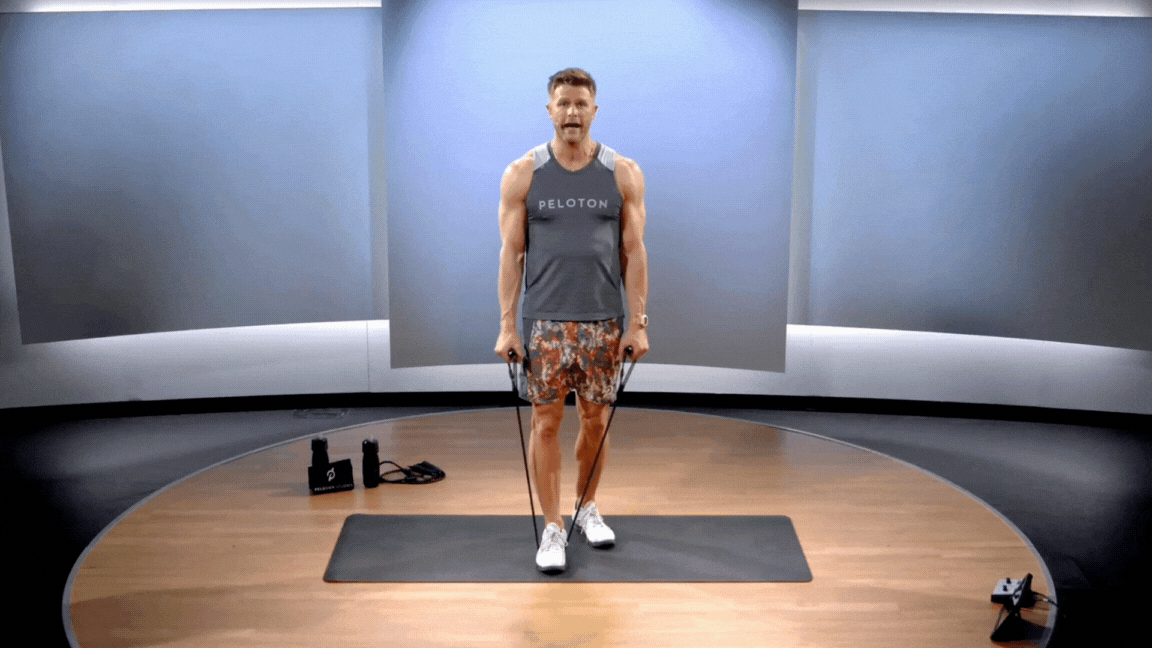
Lateral and Front Shoulder Raise
You can use this exercise to build and define your shoulders, specifically the anterior (front) deltoid and lateral (or medial) deltoid, or the front and outside portions of the shoulder muscle.
Stand with your feet staggered, right foot just in front of the left, with a resistance band under the right foot and holding a handle in each hand.
Keeping your core engaged and with a very slight bend in your elbows, raise your arms straight out to either side with palms facing down, until your elbows reach shoulder height and your arms form a “T” with your body. Slowly your arms to return to the starting position.
Then lift your arms forward up to shoulder height, and slowly lower them to return to the starting position. That’s one rep.
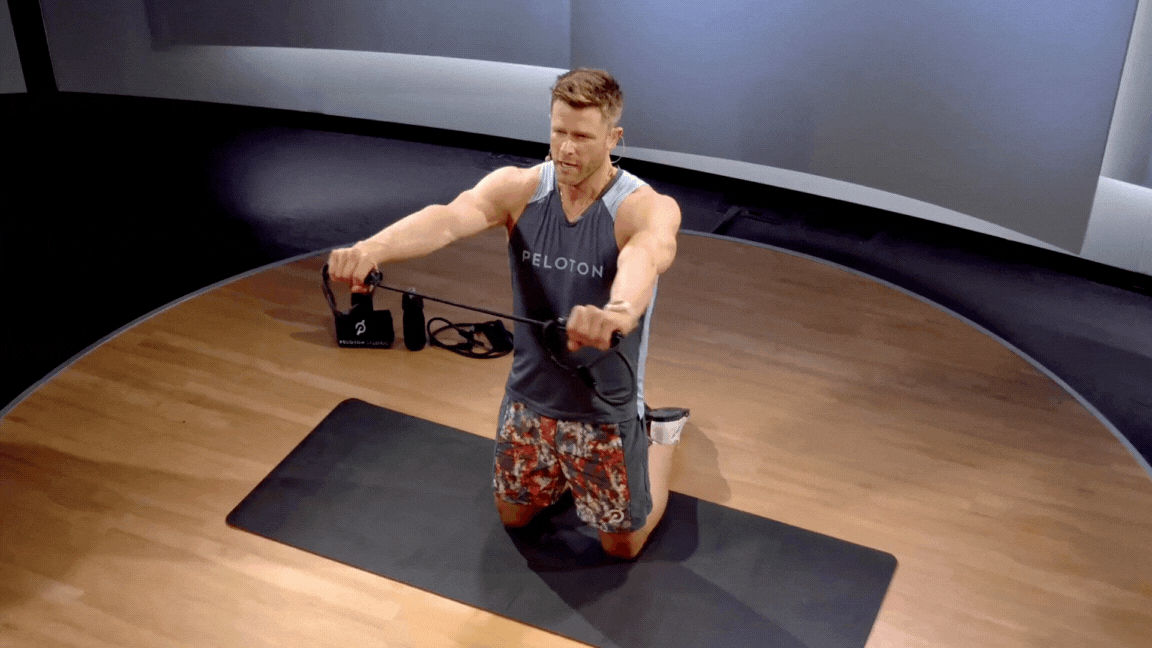
Resistance Band Pull-Apart
This upper body resistance band exercise will work the front of your chest and your shoulders.
Hold a resistance band in each hand, taking hold of the band itself (not the handles), with palms facing the floor. Extend your arms directly in front of your shoulders at chest height, keeping a slight bend in your elbows.
Keeping your shoulders down and away from your ears, pull the handles away from each other until your arms are extended directly out to the sides.
Slowly bring your arms back together in front of your chest to return to the starting position, resisting the pull of the band.
Lying Chest Press
This resistance-band alternative to a barbell bench press or dumbbell chest press will work your arms, chest, and shoulders to improve your pushing strength.
Lie flat on the floor with a resistance band running horizontally underneath your shoulders, holding a handle in each hand. Bend your elbows so that your forearms are perpendicular to the floor and your upper arms point away from your torso at about 45 degrees.
Push against the resistance band to press the handles away from your chest, extending your arms so your hands are above your shoulders.
Pause for one second, then slowly bend at your elbows to return to the starting position. That’s one rep.
Resistance Band Exercises for Lower Body Strength
Resistance band exercises provide a practical and efficient way to build and strengthen key lower-body muscle groups, such as the glutes, hamstrings, quads, and calves. Go ahead and give the following exercises a try:
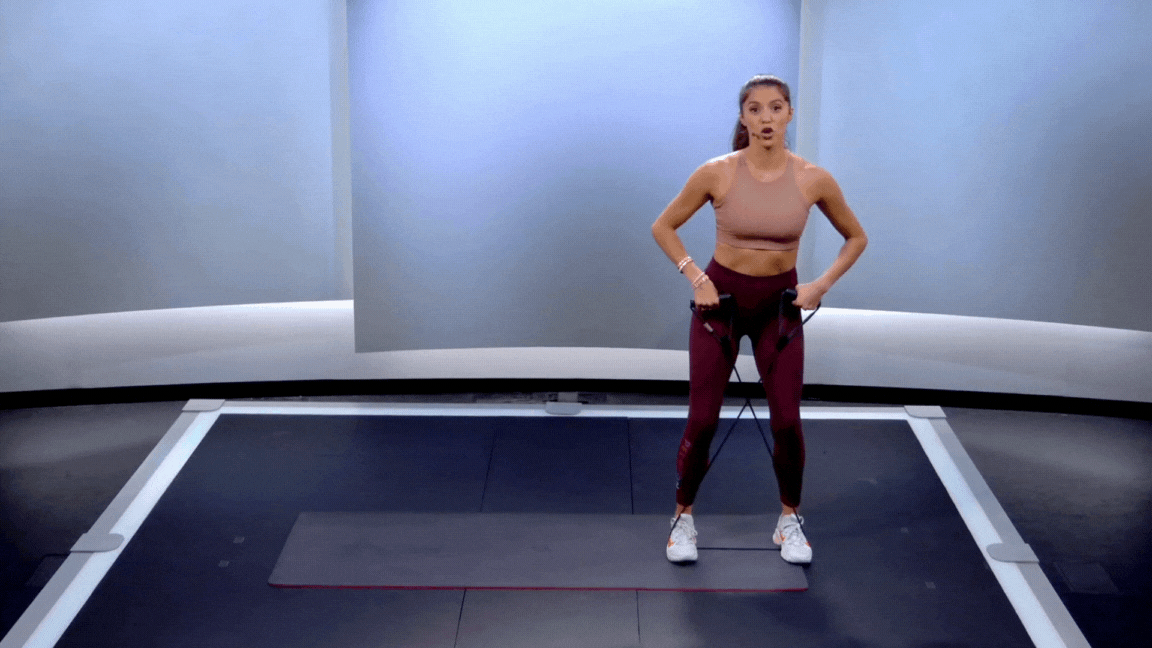
Banded Walk
This exercise is a great lower body resistance band warm-up and glute activation exercise, targeting the gluteus medius and gluteus minimus, in particular.
Stand with your feet hip-width distance apart and a resistance band running horizontally under both feet. Cross the resistance band and hold a handle in each hand so it forms an “X” in front of your body.
Bend your knees slightly and take a big step out to the right side with your right foot. Step the left foot to the right, maintaining hip-width distance between your feet.
Repeat 3–5 times, depending on how much space you have. Then reverse direction, stepping to the left until you reach your starting position.

Front Squat
This classic lower-body exercise works your quads, hamstrings, inner thighs, glutes, and core.
Stand on a resistance band with your shoulder-width distance apart. Holding a handle in each hand at shoulder height so your elbows are bent and tight to your sides.
Engage your core, then send your hips back and bend your knees to lower into a squat, keeping your chest tall.
Drive into your feet and press against the resistance band to straighten your legs and return to standing.
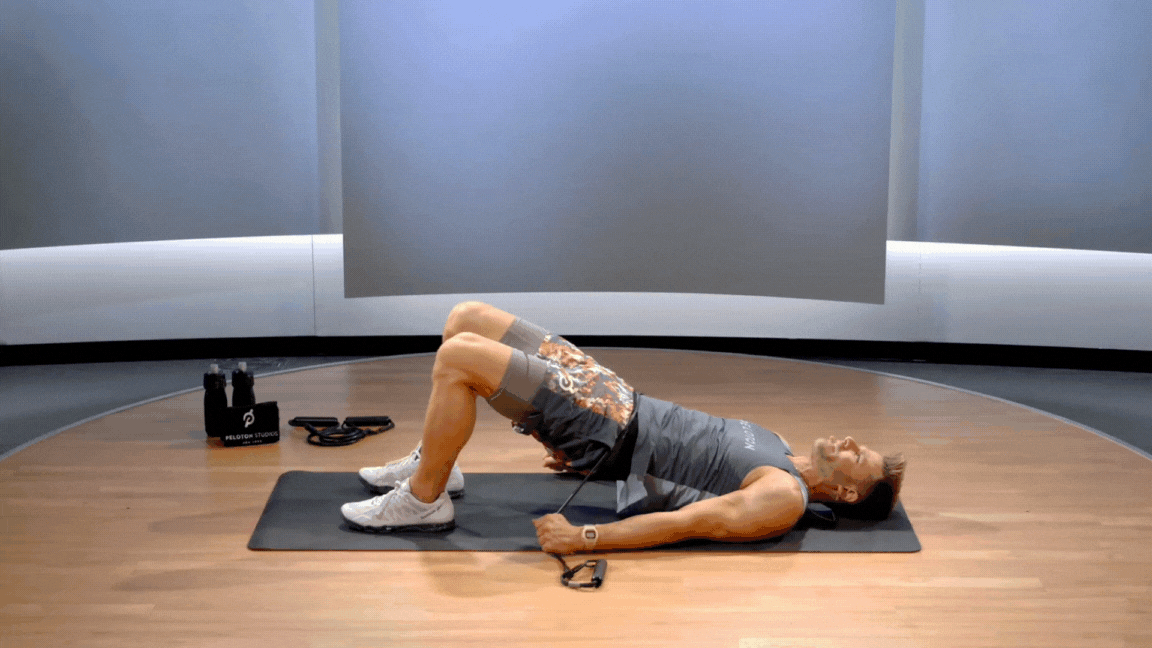
Glute Bridge
Even when done with just your body weight, the glute bridge is a powerful way to work your glutes. Hold this position as an isometric exercise (as shown above) or lift and lower for reps.
Lie flat on your back with your feet flat on the floor. Loop a resistance band over your hips, holding the ends in your hands and pressing your palms into the floor.
Engage your glutes and slowly lift your hips off the floor, pushing your legs against the band.
Hold this position for 20-30 seconds.
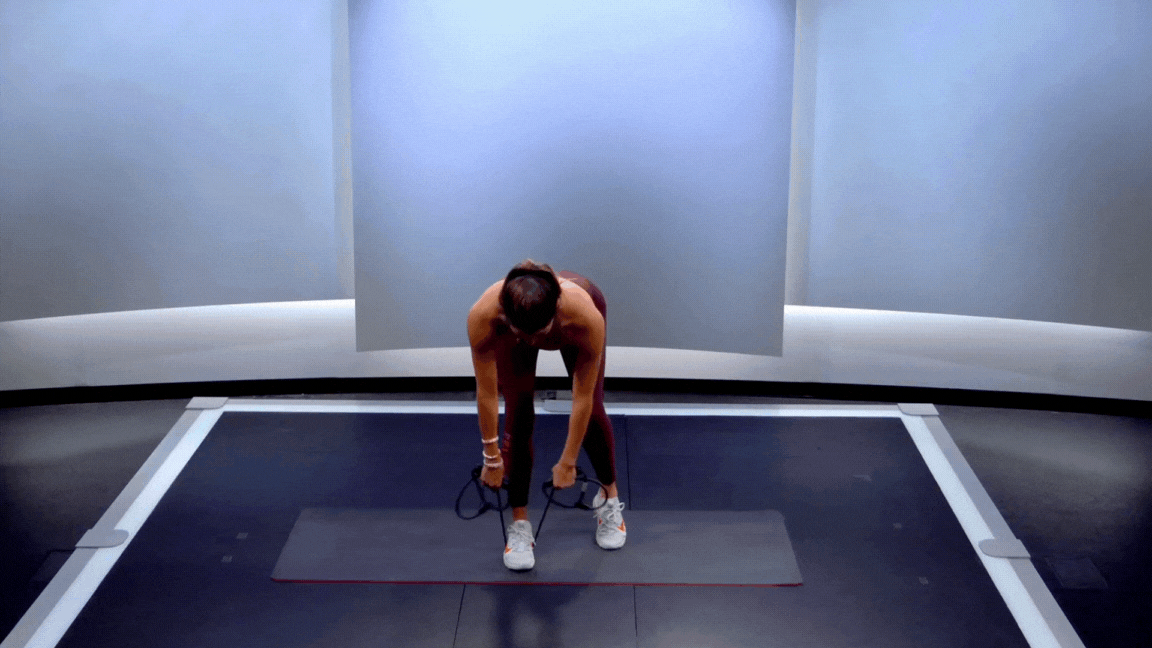
Kickstand Deadlift
During this deadlift variation, the majority of your weight should remain in your front leg.
Stand on your right foot with the ball of your left foot planted diagonally behind your right foot for balance. Keeping your right knee slightly bent, loop a resistance band underneath your right foot. Hinge at your hips and grab onto the resistance band near your foot with both hands.
Keeping your back flat, drive your hips forward, squeeze your glutes, and lift your chest to stand up tall.
Hinge at your hips to lower your chest forward with control, returning to the starting position.
That’s one rep. Do the same number of reps on both sides.
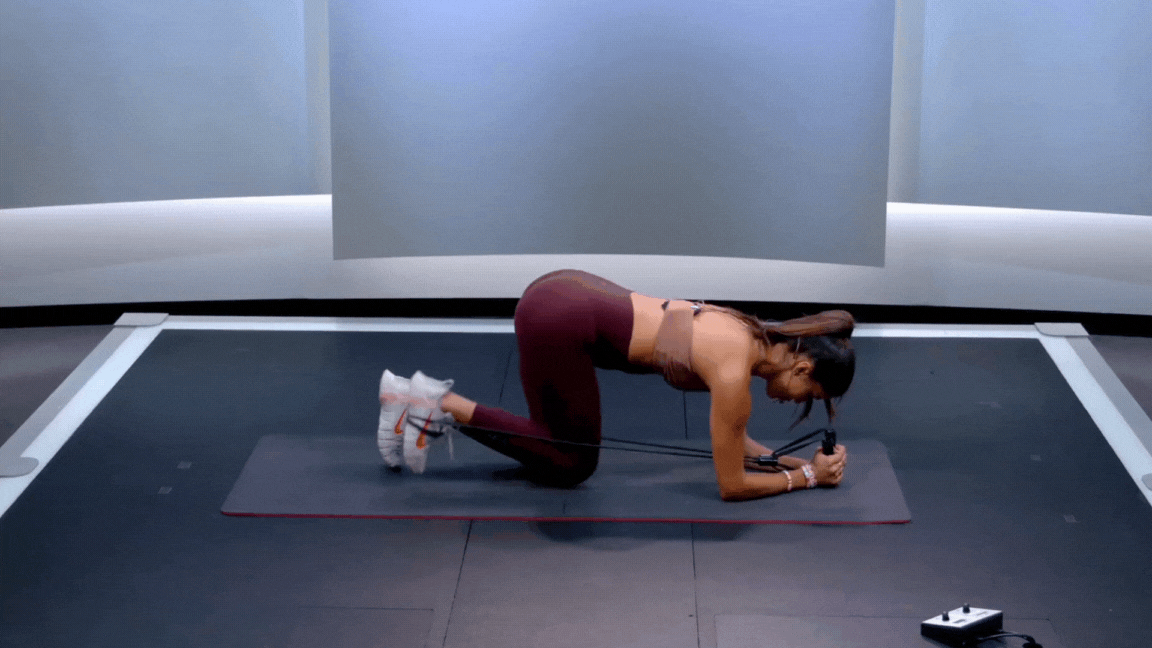
Kneeling Glute Kickback
If it’s uncomfortable for you to perform this exercise on your forearms, you can extend your arms and place your hands on the floor instead.
Start on all fours. Wrap a resistance band once around your right foot and grab a handle with each hand. Lower your elbows to the floor underneath your shoulders.
Keeping your foot flexed and core engaged (avoiding an arch in your spine), kick your right leg back behind you, straightening your right knee.
Drive your right knee toward the floor, bending your knee to return to the starting position.
That’s one rep. Do the same number of reps on both sides.
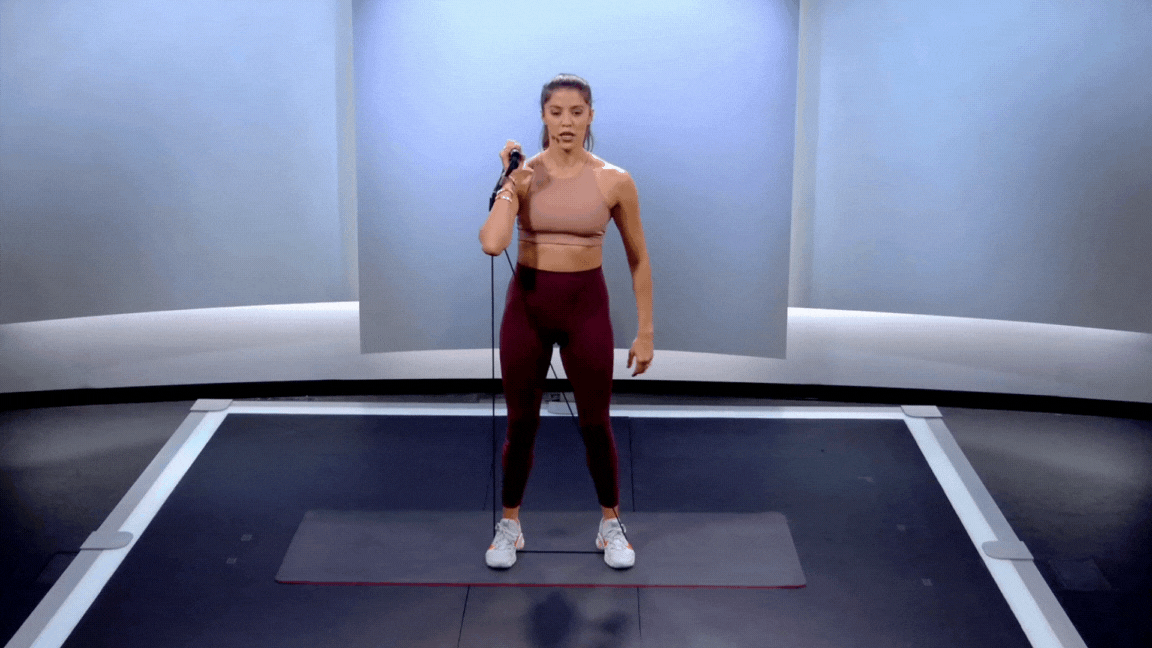
Offset Squat
During this exercise, the side of your body that the resistance band handles are lined up with will take on the majority of the weight.
Stand with your feet shoulder-width distance apart. Loop a resistance band under both feet, and grab both handles in your right hand. Bring your right hand next to your right shoulder, keeping your right elbow tucked in tight to your side.
Draw your belly button to your spine, send your hips backward and bend your knees to lower into a squat. Keep your shoulders and hips square; don’t let the band pull you to one side.
Press into your feet to push against the resistance band, straightening your legs and driving your hips forward to return to standing.
That’s one rep. Do the same number of reps on both sides.
Leg Extension
This exercise isolates and works your quads, the muscles on the front of your thighs.
Start sitting down in a chair. Wrap a resistance band around your right ankle and step on both ends of the band with your left foot.
Extend your right leg straight out in front of you, straightening your knee.
Hold for a breath, and then lower your foot to the starting position.
That's one rep. Do the same number of reps on both sides.
Split Squat
The split squat targets major muscles in your thighs, including your quads and hamstrings.
Stand with your left foot on the middle of a band, then step your right foot behind you in a split squat position. Hold the band’s handles in each hand, and bring your hands up to your shoulders with your elbows pointed toward the floor and your palms facing up.
Slowly bend both knees into a lunge position without moving your arms.
Slowly straighten your legs. Repeat on each leg 10-15 times.
Resistance Band Exercises for Core Strength
Resistance bands offer a fantastic way to level up your core work when weighted ab exercises aren’t an option.
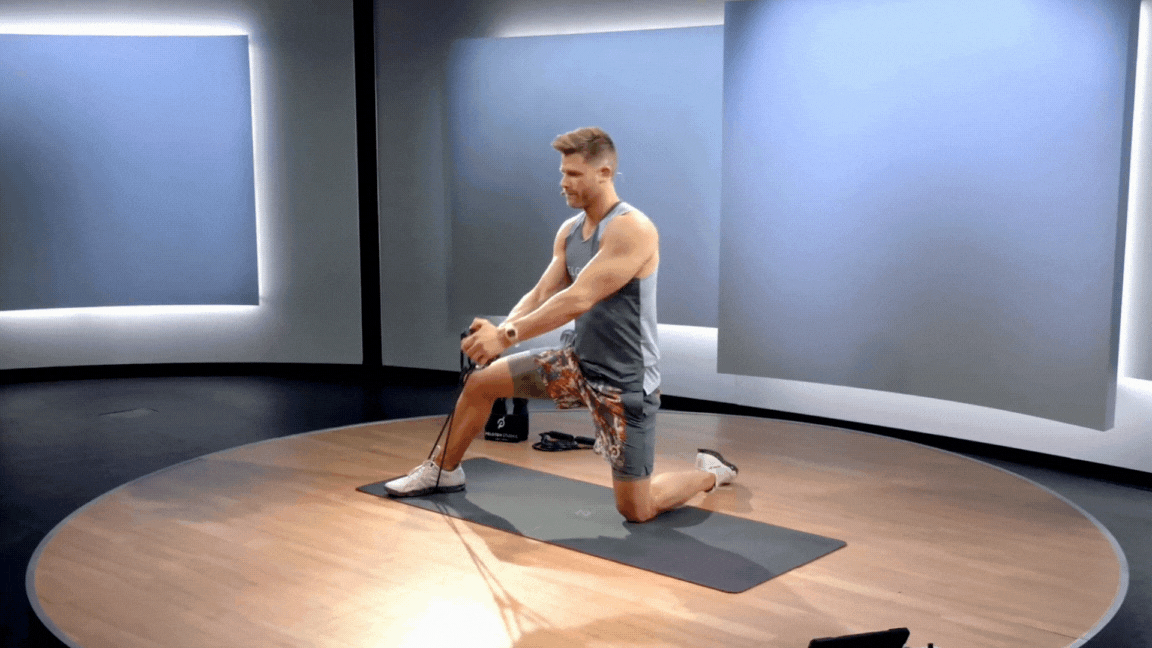
Wood Chop
Target your shoulders and core with this rotational move.
Kneel on your left leg with your right leg forward and slightly out on a diagonal. Loop a resistance band underneath your right foot and hold both handles with both hands next to the inside of your right knee.
Draw your belly button to your spine and lift the handles on a diagonal, up and over your left shoulder, keeping your hips square to the front.
Slowly lower the handles across your body, back to the inside of your right knee, resisting the pull of the band.
That’s one rep. Do the same number of reps on both sides.
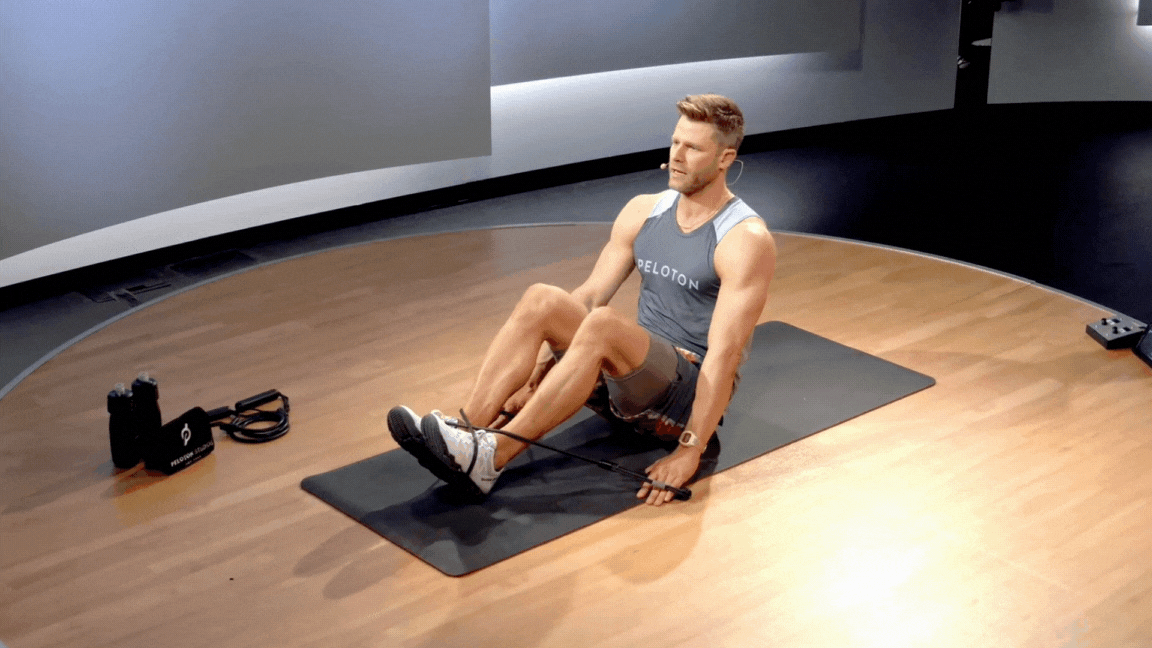
Seated Tuck-Up
This slow-and-controlled resistance band core move requires your abs and hip flexors to work hard.
Sit on the floor with your knees bent and feet on the floor in front of you. Loop a resistance band around the bottom of your feet. Cross one side of the band over the other, hold one handle in each hand, and place your hands on the floor on the outsides of your knees.
Draw your belly button toward your spine and lean back slightly. Keeping your chest tall, draw your knees toward your chest to hover your feet off the floor.
Lower your heels back to the ground with control to return to start.
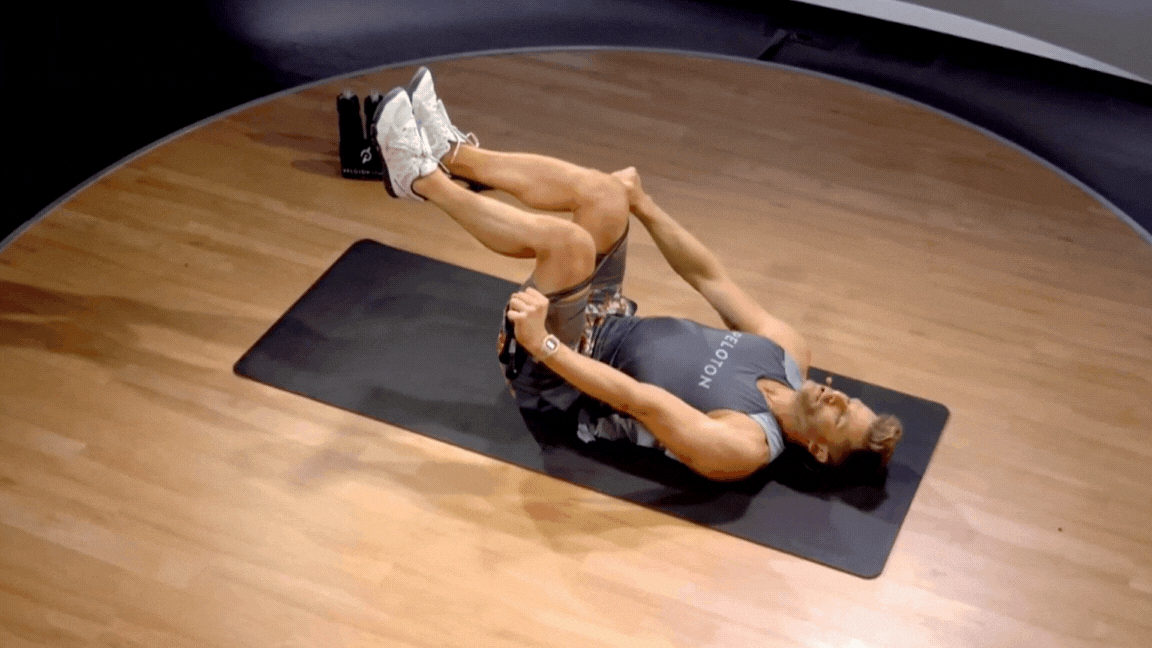
Hip Flexor-Resisted Crunch
To get the most from this abs exercise, focus on moving with control, maintaining tension throughout the movement.
Fold a resistance band in half, then grab one end in each hand. Lie face up on the floor with your legs in tabletop position (knees bent at a 90-degree angle with your shins parallel to the floor).
Press the resistance band against your thighs, and press your thighs into the resistance band. Maintain this tension throughout the movement.
Draw your belly button toward your spine and lift your head, neck, and shoulders off the floor.
Lower your head, neck, and shoulders back to the floor with control to return to start.
Try a Resistance Band Class on the Peloton App
How to Choose the Right Resistance Bands
Depending on what you want to accomplish and the types of moves you’ll be using your band for, you will want to ensure you’ve got the right band for the job. This means you’ll likely want a set of bands that come in different resistance amounts (typically light, medium, and heavy), so you can switch between bands depending on the exercise you’re doing. For example, you’ll likely be able to use a heavier band for lower-body exercises like squats and lunges, whereas you’ll need a lighter band for moves such as biceps curls and triceps kickbacks that work smaller muscles in your arms.
Altogether, choosing the right band can help you get a more effective workout and ensure you don’t overload your muscles with stress and tension from a too-taut band.
You can also choose between different types of resistance band designs. Some of the most common options include basic resistance bands that look like a long strip of elastic or one continuous loop, fabric mini loops, or tubes with handles. You can choose based on which exercise you’ll be performing, for example, mini loop bands work well for glute bridges, while handles can provide a comfortable grip during shoulder presses.
How to Get Started with Resistance Band Workouts
If you’re ready to start working out with resistance bands, check out the resistance band classes available on the Peloton App. to strengthen your muscles, increase your range of motion, and complement your cycling and running workouts. The Peloton App features resistance band classes focused on upper body, lower body, full body, and core.
Resistance bands are a win-win addition to any fitness regimen. Once you start taking advantage of their versatility, they’ll likely become a staple in yours.
This content is for informational and educational purposes only and does not constitute individualized advice. It is not intended to replace professional medical evaluation, diagnosis, or treatment. Seek the advice of your physician for questions you may have regarding your health or a medical condition. If you are having a medical emergency, call your physician or 911 immediately.
Level up your inbox.
Subscribe for a weekly dose of fitness, plus the latest promos, launches, and events.
By providing your email address, you agree to receive marketing communications from Peloton.
For more about how we use your information, see our Privacy Policy.

